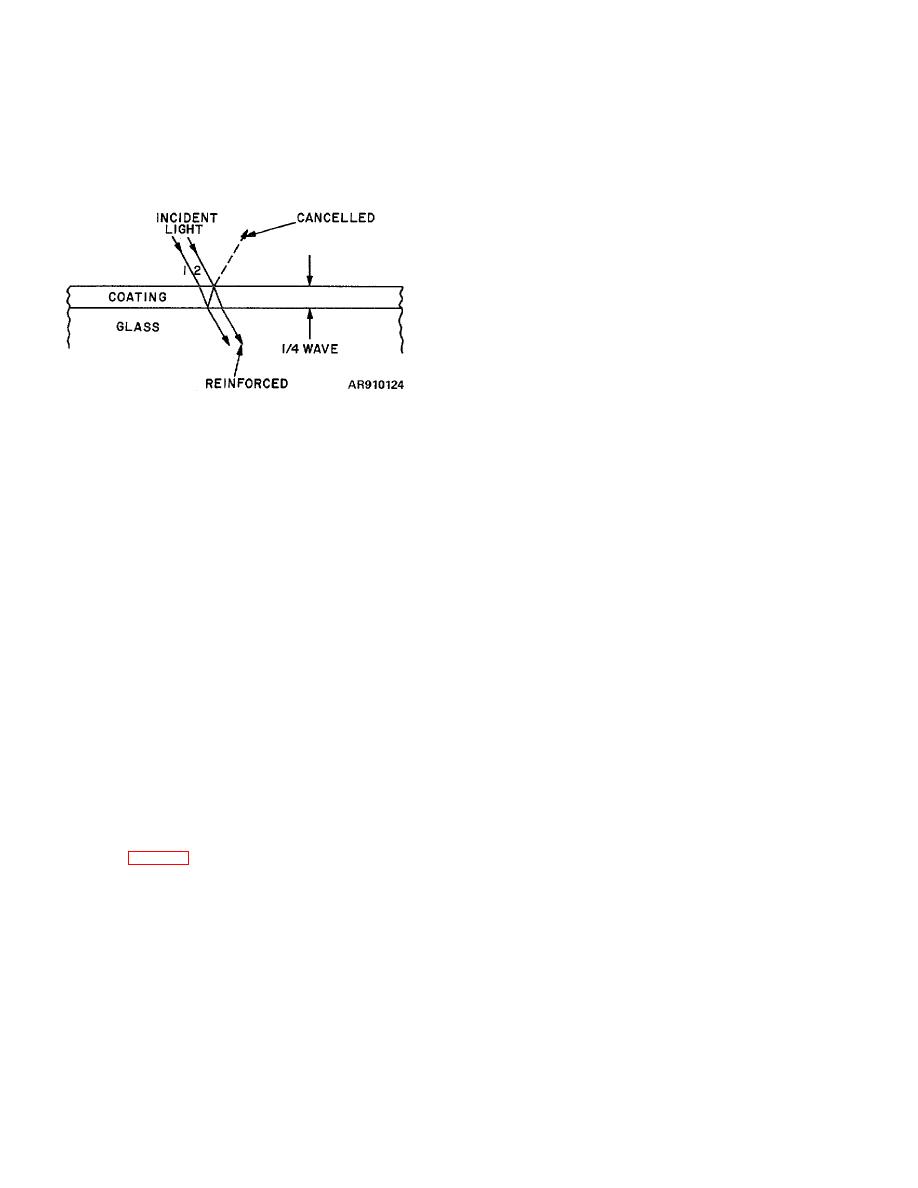 |
|||
|
|
|||
|
Page Title:
Figure 4-34. Low-reflectance coating. |
|
||
| ||||||||||
|
|
 TM 9-258
phase shift previously mentioned however, the oncoming
the reflections from the eyepiece and objective end
wave in ray 2 coincident (at the air-to-film interface) with
surfaces. If the optical elements in the instruments are
the wave from ray 1 (reflected from film-to-glass
coated, the reflection of light will have a distinctive
interface) i will be in phase. Reinforced transmission of
purplish tinge. Under certain conditions, the faces of
ray 2 will result.
lenses may appear to have a dull film or patina.
b. An alternative method is to compare the
illumination of the field of view of an instrument with the
same model number of series known to have' optical
elements that are uncoated. The instrument with coated
optics will have a much brighter field.
c. All fire-control instruments with coated optics
bear a decalcomania transfer with the following wording:
"This Instrument Has 'COATED OPTICS'. Clean Lenses
Carefully."
d. The magnesium fluoride coating is referred to as
hard coating. There are a few instruments in the field
with elements coated with what is referred to as soft
coating. The coating on these elements is not as
durable as the hard coating. A simple test will distinguish
a hard coating from a soft coating. With a soft rubber
Figure 4-34. Low-reflectance coating.
eraser, rub the coated element near the edge so as not
to impair the usefulness of the element. About 20
e. Since the wavelength is different for each
strokes will remove a soft coating, but hard coating will
different color of light, one color must be selected to
not be affected.
determine how thick the coating shall be. Green light,
4-16. Serviceability.
with a wavelength of 20 millionths of an inch, is the
a. Hard coating films on coated optics are tough
logical color to use since it is in the middle of the visible
and durable. They are insoluble in water, are not
spectrum. This color is in the brightest region and
affected by oil and alcohol, and salt water will not harm
contributes most to vision. The thickness of the coating,
them if cleaned off promptly. The coat will withstand
therefore, should be 1/4 of 20 millionths of an inch, or
temperature from -60 to +200ƒ F. They are specified to
equal to 5 millionths of an inch and result in increased
withstand a rubbing of a 3/8-inch pad of dry cotton,
transmission of green light and adjacent colors
exerting a force of 1 pound rubbed in any direction 50
(diminishing toward outer colors in spectrum). Reflection
times. However, due to the critical significance of the
of the colors at the extreme ends of the spectrum (red
thickness of the coating the effectiveness of the coating
and violet) is not eliminated completely. Therefore, light
may be completely destroyed by carelessness,
reflected from a coated optical element appears purplish,
ignorance, or rough treatment.
similar to a mixture of red and violet regardless of
b. Scratches tend to lower the quality of the lens.
coating material used. Thus presence of coating is
Wearing down of the film due to repeated cleaning is not
apparent to visual inspection. The common soap bubble
harmful to the element itself, but a reduction in thickness
or oil slick on water reflects iridescent colors because of
of the film much below one quarter of a wavelength of
the varying thickness of the film.
green light reduces its efficiency as a coated optical
f. Another useful application of magnesium fluoride
element. Partial or complete removal of the coating does
coatings is on front surface aluminized mirrors used in
not make the optical element useless but merely partly
optical instruments. In this case, a film thickness of one-
wholly takes away the benefit of the coating, leaving the
half wavelength causes reflected waves to reinforce
element as if it had not been coated in the first place. It
each other (fig 4-32).
is important that remnants of a partly deteriorated
Such coatings also may be applied to front surface
coating should not be removed, since even a partially
silvered mirrors. An aluminum or silver surface coated in
coated lens will be more effective than an uncoated one.
this manner is no longer soft and easily scratched, but
c. Coated optics slowly deteriorate under finger-
becomes harder and more durable and may be cleaned
prints, under prolonged action of atmospheric dust and
like other optical elements.
moisture, and salt water. Instruments containing coated
4-15. Identification
optics should be well sealed. Exceptional precautions
a. Whether or not an instrument is fitted with
must be taken to prevent sealing and cementing com-
coated optics can be detected readily by holding the
instrument at an angle to a source of light and observing
4-34
|
|
Privacy Statement - Press Release - Copyright Information. - Contact Us |